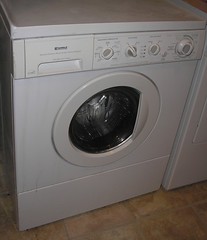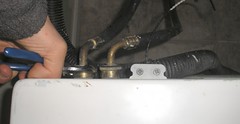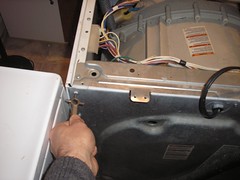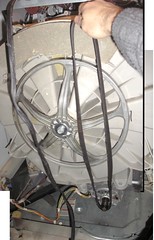Home Tech: Washing Machine Problems (1)
| Kenmore HE 3.1 cu. ft. Front Loading washer  Click for larger image |
Step one is, naturally, unplugging the machine. The big power consumer is the dryer, not the washer (this is offset somewhat by the fact that dryers usually last longer than washers do). Washing machines handle an astonishing amount of amps through a conventional 16-gauge, 3-connector cable (OK, 12 amps, but that's kind of a lot). Step two consists of shutting off the water supply. That consists of closing the two taps (see figure), screwing clockwise until they're finger tight. Then, you can detach the hoses at the washer end; they ought to be much tighter than what you can do with your hands.
 |  |
Next, you need to remove the metal panels that cover the top and back of the washer.
the top panel to the washer.  |  |
Not much to explain here. The back panel pops off pretty easily, although you need to ease it over the hose nozzles.
The tricky part (mainly because it requires CAUTION) is getting the belt onto the big wheel. The belt goes over the electric motor driving wheel (that's the shaft at the bottom) with the belt grooves on the inside of the belt. Then you stretch the belt over the top of the big wheel, and you coax the wheel through a partial rotation in order to get the belt all the way on. It's very important to make sure the spinning tub is empty, and it's also very important to make certain it's impossible for your fingers to be caught in the belt.
(Part 2)
 |  |
___________________________________________
External Links: Appliance review sites tend to be unstable and in many cases I resorted to Google caches; for example, the Sears review page no longer has reviews, but Google's cached version of the page does; or check here.
Labels: tools


